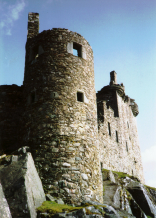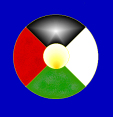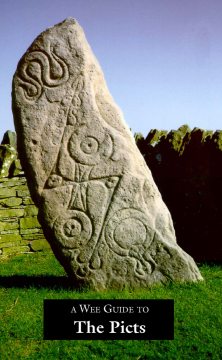History of the Picts
The Picts, their origin, language and society, remain to this day a topic of fierce debate in Scottish history. We have very little reliable information about them, and what written historical material we do have comes to us from sources outside the Pictish world – sources, moreover, that were hostile or at least unsympathetic to their culture, such as the Romans, the Scots and the Angles.
Who were the Picts? The first recorded mention of them comes from a Roman poem written in the late 3rd century ad, mentioning Picti and other barbarians. Picti, or ‘Painted Men’, was possibly the name given by the legionaries stationed on Hadrian’s Wall to the tribes of the north, against whom they stood guard. However, it may have been a general term of abuse used by the Romans for any people from beyond the wild borders of their Empire; body-painting and tattooing was practised by many cultures, but was not a feature of life within the Empire and certainly not something which any true Roman would do.
This, perhaps, is the basic problem of the Picts – they were never conquered by the Roman Empire, and remained outside that great literate circle which might otherwise have recorded some of the details of their society. But the Romans did give the Picts something more than their name. Prior to the Roman approach, the northern tribes were small and fragmentary, occupied with petty feuds and rivalries, with no real concept of themselves as a people. It is likely that the presence to the south of a large, organised and foreign enemy helped these disparate tribes to coalesce into a more coherent group, at first for collective resistance and then into the beginnings of an early kingdom.
The first record of such an instance comes from the Roman historian Tacitus, describing the campaign of Agricola and his four legions beyond the Empire’s northern border in the late 1st century ad. Central to his campaign was the defeat of a united army of tribesmen, collectively named Caledonians, in a battle at Mons Graupius. The location of this battle is unknown, but it has been suggested it was near Huntly in Aberdeenshire. The Caledonian tribes, led by one Calgacus, were heavily defeated by superior Roman weaponry, training and discipline, and Agricola completed his expedition without meeting further resistance. His supply fleet even sailed around the north of the country, locating the Orkney islands in the process. Tacitus was not unsympathetic to the Caledonian tribesmen; Calgacus is described as a man of high courage and lineage, and in his speech before the battle, wholly invented by Tacitus, he gives a ringing justification for resistance to the ever-expanding Roman Empire.
Despite Agricola’s success, no attempts were made to conquer these northern lands, although it could be argued that they had no desire to acquire such a collection of forests and mountains. But the Romans certainly respected the men of the north as enemies; they built Hadrian’s Wall, the largest piece of fortification in Western Europe, to keep them out. During their short-lived conquest of the lands up to the River Forth, they constructed yet another huge fortification, the Antonine Wall; and an entire Roman legion, the Ninth, having marched north into the lands of the tribesmen, simply vanished into the mists and forests – possibly of Galloway – never to return.
These tribesmen have been referred to as Proto-Pictish, hammered into co-operation by sporadic Roman incursions. By the 5th century ad and the Roman withdrawal from Britain, the major northern tribes had achieved some limited sense of unity, and were recognised, at least by outsiders, as one people: the Irish called them Cruithni, the ‘People of the Designs’; others knew them as the Picts. It is not known what they called themselves. Picti may itself be an adaption of their own name, transformed by the Romans into a punning reference to their practice of painting or tattooing their bodies. Certainly Pet or Pit is a common feature of Pictish place-names – Pitlochry, Pitlessie, Pittenweem – and seems to refer to a unit of land; it is not improbable that they called their own land, and themselves, by some variation of that word. The element Pent, found both in the Pentland Hills and Pentland Firth, has also been suggested as an alternative name.
We do have some recorded versions of their own origin myths. One tells of a great warrior and king, Cruithne, who ruled over Alba – a name which can mean all of Britain or just the lands to the north of Hadrian’s Wall – for one hundred years. He had seven sons, and after his death each son ruled over a portion of their father’s kingdom. The names of these sons are still preserved today in some Scottish place-names: Fib, who ruled over Fife; Cat, who ruled Caithness; and Fortriu, who ruled the lands around the Forth. The other sons were Fidach, who held Moray; Ce, Aberdeenshire, Banff and Buchan; Circenn, Angus; and Fotlaig, Atholl and Strathearn. This legend, particularly since some of the names correspond to existing but undoubtedly ancient districts, probably gives us an idea of roughly how Pictland was divided. It also indicates that Strathclyde, Dumfries and Galloway and much of the Western Highlands were not part of Pictland at all. South-west Scotland was controlled by the British Kingdom of Strathclyde. The Western Highlands were peopled by the Scots, originally from the north of Ireland, who had been arriving there for centuries; in 500 ad, under King Fergus, they invaded Argyll and established the realm of Dalriada. Pictland proper, as indicated by place-name evidence and concentration of Pictish stones, appears to have been centred in the north and east of the country.
Other myths detailing the origins of the Picts survive. Ninnius, writing in the early 9th century, states that they arrived from the north, landing first in Orkney and then sweeping down across much of northern Britain. Ninnius may have been confusing the Picts with the first early appearances of the Vikings, since the Picts, like the Norsemen, raided by sea down the east coast of Britain. An Irish legend states that the Picts came from Scythia, near the Black Sea, and migrated up through Europe before arriving in Ireland, where they helped the Irish against their enemies. The Irish King helped them settle over the sea in Alba, giving them the widows of dead Irish warriors as their wives on condition that they always chose their kings from the female line.
This notion of a culture dominated by the female, rather than the male, line has proved attractive in recent years. Such societies have existed, and both archaeological and anthropological evidence exists to suggest a period in prehistory where matriarchal Earth-Mother-worshipping cultures were conquered or displaced by patriarchal Sun-God-worshipping ones. The idea that the Picts were a remnant of these Mother-Goddess societies, however, is highly suspect, and is part of one of the most pervasive myths surrounding the Picts: that they were some kind of lost people, an ancient survival of a prehistoric culture. If the Picts were a matrilinear society, they would have been unique in Dark Age western Europe. The only evidence to support this idea is a throwaway comment in the Venerable Bede’s History of the English Church and Peoples, written in the 8th century ad, where he repeats the Irish myth. This legend was particularly attractive to the Dalriadan Scots, as it gave them a claim to kingship over the Picts, and they probably repeated it at every opportunity.
The Picts were almost certainly a Celtic society of farmers and hunters with many parallels to other cultures across northern Europe. The Celts are a disparate group of peoples, sharing common linguistic, social and artistic traits, who emerged from the Near East during the Bronze Age around 1000 bc. They migrated and conquered their way across Europe before being subsumed into the Roman Empire (with the exception of the Irish and the Caledonian tribes) before finally being swamped by the Germanic invasions of Goths, Huns, Vandals, Franks, Angles, Saxons and others in the first few centuries ad. Only Scotland, Ireland, Wales and Brittany remained as a Celtic fringe.
Within that Celtic fringe is one major division, seen principally in language. Celtic languages are divided into two groups: Brythonic: Welsh, Cornish, Breton and the language of the ancient Britons; and Goidelic: Scots and Irish Gaelic and Manx. What little evidence we have of the Pictish language strongly suggests that it was a Brythonic Celtic tongue: compare, for example, the number of towns beginning Aber- (meaning a confluence or a river mouth) in eastern Scotland with those in Wales.
Pictish society would have been similar in many important aspects to other European barbarian cultures. Tribal in nature, it would have been organised around a chief or chieftain who would have had a retinue of elite warriors. They would have been rewarded with honour, feasting and with moveable wealth, ranging from gold and jewels to cattle and slaves, obtained by raiding other communities. The poorer members of the community, unable to afford the weaponry or the leisure time of the warriors, would have occupied themselves with subsistence farming, paying small tributes to their chief and fighting only in desperate self-defence. With the withdrawal of the Romans and the growing organisation of the Picts, the opportunities for raiding increased enormously, and successful chiefs began to build on established power-bases. Occasionally, one chief might become powerful enough to exact tribute from his neighbours, along with an acknowledgement of superiority, and the notion of a High King – perhaps as overlord, perhaps simply first among equals – would develop.
Pictland was becoming more cohesive, with power centralised in the persons of chiefs and kings. The arrival of Christianity spurred things on even further. The Christian church was an enormous force for the organisation of a kingdom; a literate clergy could form a basis for an administration, whilst their theology helped to justify and confirm royal power. The most famous missionary to the Picts was St Columba, an Irish monk of noble blood, who travelled from Iona up the Great
Glen to the palace of the powerful Pictish king, Bridei (or Brude) near Inverness or possibly at Urquhart. According to St Adamnan, Columba’s hagiographer, he had a magical duel with Bridei’s chief magician, Broichan. St Columba was naturally victorious, and even cowed the fearsome kelpie, or water-horse, which inhabited Loch Ness. In reality, all that Columba achieved was the opening up of northern Pictland to Christian missionaries, and the acquisition of the island of Iona as a monastic centre.
Christianity also spread into Pictland from the south. St Ninian, based at Whithorn in the British kingdom of Strathclyde, St Kentigern (or Mungo) and St Rule all made incursions into pagan Pictland from the 5th century onwards. Although ‘conversion’ is probably too strong a word for what they achieved – most of the population would have continued to practise the beliefs and customs of their ancestors – gradually the new religion spread and absorbed or displaced the old.
The struggle for power in these kingdoms, however, went on between the northern Picts, their southern kinsfolk, the Dalriadan Scots and the Britons of Strathclyde and Lothian. New enemies were emerging, too. The lands south of Hadrian’s Wall had fallen to the invading Saxons and Angles, and it was the latter, from Northumberland in particular, who were to prove the most threatening. From the late 6th century, the power of the Kingdom of Northumbria had been growing steadily. In 603 ad, alarmed at their expansive and aggressive nature, King Aedan of Dalriada mounted an invasion of their territory.
Aedan was a good example of the kind of king emerging from the northern lands. He was Scottish in ancestry, and had fought for many years with his Pictish neighbours, although he married a Pictish princess, marking the way forward for the coming together of the two peoples. Marching south with his allies from Strathclyde, and doubtless from Pictland as well, he met the Northumbrians in battle at Degastan. The result was a resounding victory for the Angles; two of Aedan’s sons were killed, his army was destroyed and Aedan himself disappeared from history.
Degastan marked the beginning of Northumbrian expansion northwards, and the immediate losers were the Britons of Lothian and the southern Picts. Between around 657 ad and 685 ad much of southern Pictland was occupied by the Angles, then at the height of their power. The occupation was hated by the Picts, who attempted rebellion more than once. The Angles even installed their own bishops, and it looked as if much of Pictland would be forever absorbed into a greater Northumbria.
But one man emerged who was to have as much influence on the future course of history as Robert the Bruce: Bridei, grandson of King Neithon of Strathclyde – not to be confused with King Bridei who received St Columba. Bridei’s campaign began around 680 ad, when he conquered and brought under his control the northern Pictish lands. By 683 ad he had subdued the Scots, even besieging and assaulting their capital at Dunadd in Argyll. A strong and determined ruler, his ultimate aim was achieved in 685 ad when he brought the Northumbrians to battle at Nechtansmere – also known as Dunnichen – near Forfar in Angus.
Nechtansmere ranks alongside Bannockburn as a decisive battle which shaped the destiny of an entire country, for without it there is every chance that the later kingdom and nation of Scotland would never have existed. Bridei knew the power of the Northumbrians; he also knew that they were supremely confident and despised their northern enemies. Playing on their arrogance, he lured their army northwards into hilly, broken terrain where their superior strength and numbers were of limited value. Dividing his army in two, he sent the weaker half forward to confront the enemy, keeping the bulk of his troops in hiding behind Dunnichen hill. After a short engagement, the weaker Picts withdrew back over the hill. The exultant Angles broke ranks and pursued them, only to come face to face with the main Pictish force, formed up in battle array. Trapped by the Picts, with no escape except through the marshy terrain at the foot of the hill, the Northumbrians were defeated with great slaughter. Their King, Egfrid, and his retinue were all killed. The power of the Northumbrian kingdom was broken forever, beginning a long slow decline until it was absorbed into the emerging kingdom of England.
Bridei’s momentous victory is recorded in stone on the beautiful cross-slab in Aberlemno churchyard, a few miles from the site of the battle. It marked the beginning of a period of ascendancy for Pictland, united now under one ruler. Several other kings followed Bridei after his death in 693 ad, and although Northumbria continued to be a threat, it was the Dalriadan Scots who were now seen as the greatest menace. Perhaps the most obvious sign of this comes from the reign of Nechtan Mac Derile, who ruled from 706 ad to 724 ad. Perceiving that, since Nechtansmere, the Irish churchmen – many with strong connections with the Scots – had gained a disturbing amount of influence in his realm, he adopted the practices of the Northumbrian church and expelled the Columban monks to the west of the country.
Nechtan was a religious man, and eventually resigned his kingship and became a monk. Out of the confused struggle for power, following his abdication, emerged a new dynasty, founded by Oengus Mac Fergus. Oengus was a violent and energetic man who ruled from 731 ad to 761 ad; he crushed his enemies, executed the King of Atholl by drowning, captured Dunadd, conquered Dalriada and became the first
king of both Picts and Scots. His expanding ambitions foundered finally on the rock of Dumbarton as he tried, with Northumbrian help, to add the Kingdom of Strathclyde to his possessions in 756 ad.
Oengus died in 761 ad, and with him died the union of Pictland and Dalriada. Under King Aed, the Scots threw off Pictish rule and once more asserted their independence. But the idea of a united kingdom had been born, and was realised again under Constantine Mac Fergus, who ruled Pictland from around 789 ad to 820 ad. His son, Donald, became King of Dalriada, and on his death in 811 ad Constantine gained his son’s throne as well.
After Constantine’s death the kingdoms again split apart, and a series of generally short-lived kings followed him. However, it must be appreciated that, by this time, intermarriage, particularly among the royal and aristocratic families, had made the Pictish and Scottish rulers almost interchangeable, and a unification under one royal house could be seen as inevitable.
The final pressure for union came from outside, in the form of the Vikings. What began as a trickle of Norse trader-pirates turned into an annual flood of raiders and settlers, and in 839 ad a united army of Picts and Scots was destroyed by the Vikings. Neither kingdom could exist in isolation any more. The Picts, on the east, were in the direct line of attack, and the Dalriadan Scots were cut off from their Irish cousins. Chance, more than anything else, determined which kingdom and culture would dominate.
Kenneth Mac Alpin, King of Dalriada, was the one to snatch the prize, and in 842 ad he moved his court to the ancient Pictish royal centre at Scone. From Dunadd he brought the Stone of Destiny, an ancient artifact used in the inauguration of Scottish Kings, now kept in Edinburgh Castle. Legend states that he invited the Pictish nobles to a feast before treacherously massacring them, although this is probably untrue; the Pictish nobility had already been decimated in battle by the Vikings. Although there was some resistance, by 848 ad Kenneth Mac Alpin had become the first true King of Scots – a name which must now be expanded to include the Picts as well. By moving the centre of his royal power, by diplomacy, force of personality and of arms, and by providing a single rallying point against the Norse invaders, Kenneth Mac Alpin did more than merely rule two kingdoms; he made them into one.
From this point on, Pictish language and culture declined. Gaelic was the language of the court and of the new ruling class, and of the resurgent Columban church. But the court was established in Pictish territory, in important royal centres such as Scone, Dunkeld, Abernethy and Dunfermline, and the Pictish ecclesiastical centre at St Andrews became the pre-eminent bishopric in all of Scotland. Indeed, the old Scottish power-base in Argyll and the Western Highlands drifted out of royal control, some parts of which never fully returned until the modern era, and it was the Pictish heartlands which became the foundations of the Scottish nation. Although the Picts are lost to history, they have never truly gone away. Their legacy in stone is still with us.
© Duncan Jones 2018










